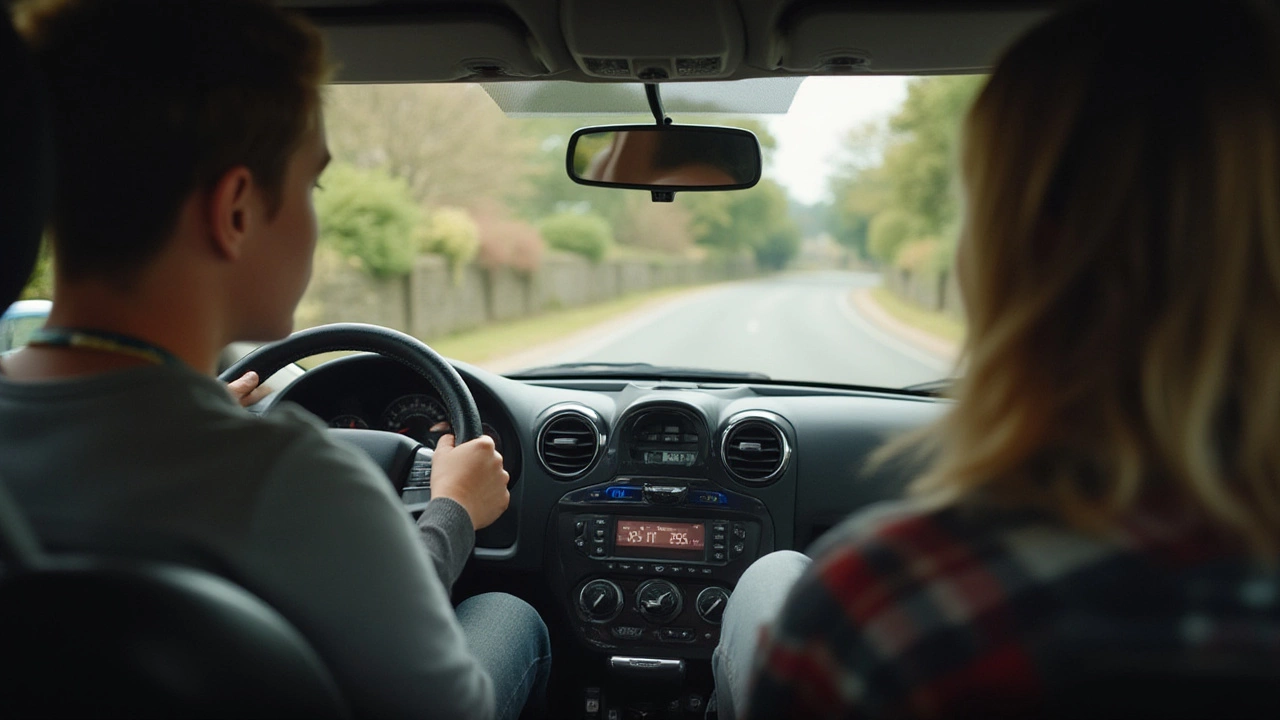Ask five people how long a driving lesson should last and you’ll get five different answers. That’s not an accident—it’s the one thing almost every learner wonders, and the reality is surprisingly flexible. Picture this: you’re sitting in a car for your first lesson, the engine hums, and you're hyper-aware of how quickly a clock can move when you’re anxious. If you’ve ever felt puzzled by why some lessons seem to flash by while others drag, you’re far from alone. The timing of lessons isn’t about what’s written in some dusty manual; instead, it's usually built around what works best for real people in everyday life.
Standard Lengths: What’s Normal for Driving Lessons?
Most people begin their driving journey with sessions that last about an hour. In the UK, 60 minutes is the classic, go-to option. It’s the industry standard for a reason: it balances time for learning with the mental stamina most newbies can manage. But here’s where it gets interesting—many driving instructors are shifting toward 90-minute lessons, and some stretch sessions to a full two hours. The idea is pretty simple: the longer you’re behind the wheel, the more real-life road situations you can experience in one go.
Why does the length matter? Consider this: studies by the DVSA (Driver and Vehicle Standards Agency) show spaced repetition cements skills. A solid block of practice—say, 90 minutes—means you move past basic starts and stops. You get to experience more complex stuff, like roundabouts, parking, and awkward junctions, all in one lesson. So, while hour-long lessons are totally normal, don’t be surprised if your instructor nudges you toward longer sessions once you’ve mastered the basics.
There’s also the logistics side. If you can only fit in one lesson a week, your instructor might recommend making it a longer session. More time behind the wheel each visit can help you stay sharp between lessons, instead of always having to backtrack and recap what you learned last time. On the flip side, if nerves are hitting hard, you might find that sticking to a 60-minute lesson at the start makes it easier to stay focused and confident.
And then, of course, there are intensive courses. These are a whole different beast entirely, squashing the content of weeks or months of driving into just a few days. In that world, you could be looking at four- or five-hour marathons, with just short breaks in between. It’s not for everyone, but it works for folks in a rush—like students before uni, or those who need a licence for a job change. Think of these longer sessions as the driving-world equivalent of cramming for an exam—not ideal for deep learning, but sometimes necessary.
To sum up the “normal” range: most standard driving lessons run for 60–90 minutes. Beginner lessons might be on the shorter end; advanced learners often benefit from longer blocks. If you’re tight on time or anxious about the process, don’t be afraid to ask for what fits your pace. Instructors are used to tailoring lessons to each person’s needs—after all, nobody learns exactly the same way.
Why Lesson Timing Matters for Different Learners
It’s pretty wild how much your mindset and energy change across a lesson. During the first 20 minutes, you’re focused, alert, and probably soaking up info like a sponge. But what about the 50-minute mark? Now, you’re more tired and prone to silly mistakes. Plenty of new drivers hit an invisible wall around an hour in—they get mentally drained and start missing details they nailed earlier.
That’s one big reason lesson durations are so carefully considered. For folks just starting out, a full 90-minute stint can feel overwhelming. On the other side, drivers prepping for their test might actually benefit from long, single blocks—driving instructors often say these marathons simulate the pressure and endurance needed for the real thing. Some instructors even tweak lesson lengths mid-course, adjusting them as the learner’s confidence and endurance grow.
Want a tip from instructors who’ve done this for decades? Pay attention to your energy. If you feel your concentration flagging just past the halfway point, it’s probably a sign that your lessons should be a bit shorter for now. Some learners split lessons into two shorter sessions a week, rather than one long one. This breaks up the learning, lets you recover, and means you’re usually driving at your mental best.
It also matters what you’re working on during each lesson. A session focused on tricky manoeuvres—parallel parking, reversing around corners, bay parking—takes a ton of brain power. These skills need precision, feedback, and time to reset your nerves between attempts. Cramming that into the back half of a two-hour lesson is a recipe for frustration. On the other hand, long drives at changing speeds or practicing dual carriageways are often more effective in longer, uninterrupted lessons.
Here’s another factor: traffic and location. City centres are full of hazards and stops; rural lessons cover more distance but might lack certain road scenarios. Sometimes, instructors extend lessons to give you a taste of driving in different settings. Think about it—ten minutes spent crawling through traffic feels very different to cruising along a quiet B-road. Adjusting lesson times lets you hit a variety of real-world situations, not just clock-watch to a set schedule.
One last thing to remember: driving is as much about muscle memory as it is about knowledge. Longer lessons give you a chance to repeat skills until they’re second-nature, but there’s always a balance. If you’re wiped out at the end, the extra practice won’t stick. Stay honest with your instructor about when your brain feels “full”—most are happy to keep things flexible until you find your rhythm.

What Else Influences Lesson Length?
Cost plays a big part. You might notice packages for double lessons (usually two hours) are priced at a slight discount compared to two singles. Instructors like them because less time is wasted on pick-ups and drop-offs, and learners have a shot at deeper, less rushed progress. From a budget angle, if you can handle longer lessons, it can actually be a savvy move in the long term—especially if you’re aiming to pass quickly.
But the real kicker is availability. Scheduling is often a game of Tetris for learners and instructors alike. Popular time slots—after school or work—book out fast. Sometimes, grabbing a double-slot on a Saturday morning is the only way to squeeze lessons into a packed week. Factor in instructor holidays, bad weather (nobody learns well when it’s chucking down), and sudden events, and you start to see why flexibility about lesson length helps everyone keep moving forward.
Then there’s the car itself. Some learners pick manual transmission, which naturally takes more time to master because of clutch control and gear changes. If you go for automatic, you might find you need fewer lessons, with each session more focused on road craft and less spent grappling with biting points. This can change how long your lessons are—and how many you end up booking before feeling “test ready.”
Another thing instructors look for is confidence level. Shy or anxious drivers tend to benefit from shorter, more frequent practices with lots of encouragement. On the flip side, if you’re already keen and picking things up fast, they’ll probably ask if you want to stretch lessons out and cover more ground each time. There’s no “one-size-fits-all”—finding that sweet spot for your learning style is half the battle.
One often-overlooked factor: weather. Ever tried mastering hill starts in a torrential downpour, or practicing emergency stops on glare-ice? Instructors sometimes adapt lesson length on the fly depending on road conditions. If visibility drops or roads become hazardous, a shorter, focused lesson is safer—while sunny, dry days are perfect for longer, back-to-back driving stints that help build experience quickly.
And if you’re learning in a bilingual area, like parts of Wales or Scotland, some instructors add cultural awareness points and language tips to the lesson, which can lengthen the time you spend in the car. Consider that if you’re learning somewhere unique; extra time could mean extra confidence when you’re dealing with signs and rules in two languages!
Tips for Making Every Driving Lesson Count
First, don’t just count minutes—focus on what you’re doing with them. Before each lesson, jot down what you want to practice. Got a part you always mess up? Tell your instructor and zone in on that first, when your brain is fresh. Building this habit means even short lessons pack a punch.
Use every feedback opportunity. After a lesson, spend five minutes reviewing what worked and what didn’t. A lot of learners skip this, but it’s golden—especially if your instructor gives you written notes or a progress sheet. You’ll walk into the next lesson clear-headed and confident, not guessing what comes next.
If you can, mix things up. Book a longer lesson every now and then, especially for things like night driving, motorway practice, or test simulations. Getting used to a full test-length drive (around 40 minutes, with no breaks!) reduces nerves when the real thing rolls around. Some instructors let you split a double lesson between different practice zones—use the first half for busy streets, the second for quiet manoeuvres.
Bring fuel—literally and figuratively. Make sure you’re not hungry or dehydrated for your lesson, especially if it’s long. Nobody learns well when they’re running on empty. Bring a bottle of water, and maybe a small snack for before you start if you book a double.
Sleep matters more than you think. Learning to drive is physically and mentally draining, and studies at universities like Exeter show we remember more and make fewer mistakes after a decent night’s rest. Plan your lessons for a time of day you know you’re alert and focused—afternoon lessons might be perfect for night owls, while early birds might want that morning freshness.
Don’t forget support at home. Practicing with parents or friends between lessons can make shorter lessons go further, because you’re reinforcing what you learned and not spending the whole next lesson in review mode. Be sure your supervising driver is confident themselves and up to date on the latest rules—standards change, and the Highway Code isn’t quite what it was even five years ago.
Finally, stay honest with yourself. If you feel exhausted or overwhelmed after an hour, it’s OK to say so. Pushing through when you’re not absorbing information just wastes time and money. On the flip side, if you start hitting your stride, trying longer lessons could shrink the months-long slog of learning to drive into a much more manageable few weeks. Always tailor the experience to what works best for you. Ask questions, request tweaks, and keep your lessons focused. You’ll be on the road, test certificate in hand, before you know it.

